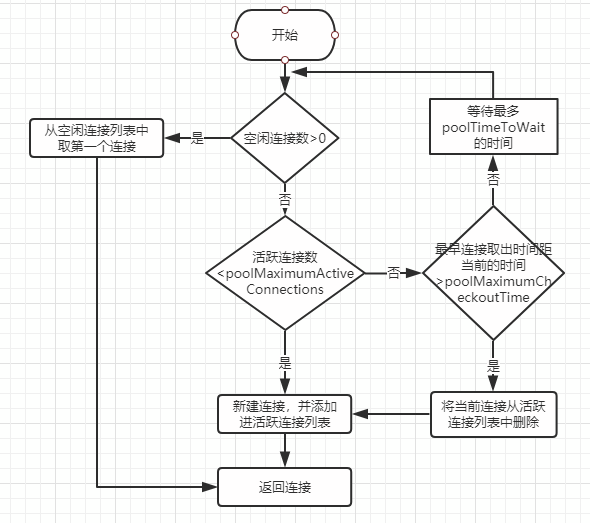MyBatis连接管理(2)
MySQL连接管理
在调用SqlSessionFactory的openSession函数时,只是创建了一个DefaultSqlSession实例,并没有真正去连接MySQL:
private SqlSession openSessionFromDataSource(ExecutorType execType, TransactionIsolationLevel level, boolean autoCommit) {
Transaction tx = null;
DefaultSqlSession var8;
try {
Environment environment = this.configuration.getEnvironment();
TransactionFactory transactionFactory = this.getTransactionFactoryFromEnvironment(environment);
tx = transactionFactory.newTransaction(environment.getDataSource(), level, autoCommit);
Executor executor = this.configuration.newExecutor(tx, execType);
var8 = new DefaultSqlSession(this.configuration, executor, autoCommit);
} catch (Exception var12) {
this.closeTransaction(tx);
throw ExceptionFactory.wrapException("Error opening session. Cause: " + var12, var12);
} finally {
ErrorContext.instance().reset();
}
return var8;
}
只有当真正执行SQL语句时,比如query,才通过SimpleExecutor调用doQuery,最终通过Transaction调用DataSource的popConnection:
private PooledConnection popConnection(String username, String password) throws SQLException {
boolean countedWait = false;
PooledConnection conn = null;
long t = System.currentTimeMillis();
int localBadConnectionCount = 0;
while(conn == null) {
PoolState var8 = this.state;
synchronized(this.state) {
if (!this.state.idleConnections.isEmpty()) {
conn = (PooledConnection)this.state.idleConnections.remove(0);
if (log.isDebugEnabled()) {
log.debug("Checked out connection " + conn.getRealHashCode() + " from pool.");
}
} else if (this.state.activeConnections.size() < this.poolMaximumActiveConnections) {
conn = new PooledConnection(this.dataSource.getConnection(), this);
if (log.isDebugEnabled()) {
log.debug("Created connection " + conn.getRealHashCode() + ".");
}
} else {
PooledConnection oldestActiveConnection = (PooledConnection)this.state.activeConnections.get(0);
long longestCheckoutTime = oldestActiveConnection.getCheckoutTime();
if (longestCheckoutTime > (long)this.poolMaximumCheckoutTime) {
++this.state.claimedOverdueConnectionCount;
this.state.accumulatedCheckoutTimeOfOverdueConnections += longestCheckoutTime;
this.state.accumulatedCheckoutTime += longestCheckoutTime;
this.state.activeConnections.remove(oldestActiveConnection);
if (!oldestActiveConnection.getRealConnection().getAutoCommit()) {
try {
oldestActiveConnection.getRealConnection().rollback();
} catch (SQLException var16) {
log.debug("Bad connection. Could not roll back");
}
}
conn = new PooledConnection(oldestActiveConnection.getRealConnection(), this);
conn.setCreatedTimestamp(oldestActiveConnection.getCreatedTimestamp());
conn.setLastUsedTimestamp(oldestActiveConnection.getLastUsedTimestamp());
oldestActiveConnection.invalidate();
if (log.isDebugEnabled()) {
log.debug("Claimed overdue connection " + conn.getRealHashCode() + ".");
}
} else {
try {
if (!countedWait) {
++this.state.hadToWaitCount;
countedWait = true;
}
if (log.isDebugEnabled()) {
log.debug("Waiting as long as " + this.poolTimeToWait + " milliseconds for connection.");
}
long wt = System.currentTimeMillis();
this.state.wait((long)this.poolTimeToWait);
this.state.accumulatedWaitTime += System.currentTimeMillis() - wt;
} catch (InterruptedException var17) {
break;
}
}
}
if (conn != null) {
if (conn.isValid()) {
if (!conn.getRealConnection().getAutoCommit()) {
conn.getRealConnection().rollback();
}
conn.setConnectionTypeCode(this.assembleConnectionTypeCode(this.dataSource.getUrl(), username, password));
conn.setCheckoutTimestamp(System.currentTimeMillis());
conn.setLastUsedTimestamp(System.currentTimeMillis());
this.state.activeConnections.add(conn);
++this.state.requestCount;
this.state.accumulatedRequestTime += System.currentTimeMillis() - t;
} else {
if (log.isDebugEnabled()) {
log.debug("A bad connection (" + conn.getRealHashCode() + ") was returned from the pool, getting another connection.");
}
++this.state.badConnectionCount;
++localBadConnectionCount;
conn = null;
if (localBadConnectionCount > this.poolMaximumIdleConnections + this.poolMaximumLocalBadConnectionTolerance) {
if (log.isDebugEnabled()) {
log.debug("PooledDataSource: Could not get a good connection to the database.");
}
throw new SQLException("PooledDataSource: Could not get a good connection to the database.");
}
}
}
}
}
if (conn == null) {
if (log.isDebugEnabled()) {
log.debug("PooledDataSource: Unknown severe error condition. The connection pool returned a null connection.");
}
throw new SQLException("PooledDataSource: Unknown severe error condition. The connection pool returned a null connection.");
} else {
return conn;
}
}
流程图如下:

这里需要注意的是,最终返回的是利用JAVA动态代理创建的实际连接的代理连接PooledConnection(具体原理会在另外一篇博文里详细解释):
public Connection getConnection() throws SQLException {
return this.popConnection(this.dataSource.getUsername(), this.dataSource.getPassword()).getProxyConnection();
}
当调用实际连接的方法时,就会进入PooledConnection的invoke方法:
public Object invoke(Object proxy, Method method, Object[] args) throws Throwable {
String methodName = method.getName();
if ("close".hashCode() == methodName.hashCode() && "close".equals(methodName)) {
this.dataSource.pushConnection(this);
return null;
} else {
try {
if (!Object.class.equals(method.getDeclaringClass())) {
this.checkConnection();
}
return method.invoke(this.realConnection, args);
} catch (Throwable var6) {
throw ExceptionUtil.unwrapThrowable(var6);
}
}
}
该方法会拦截实际连接的close方法,实际调用DataSource的pushConnection方法:
protected void pushConnection(PooledConnection conn) throws SQLException {
synchronized(this.state) {
this.state.activeConnections.remove(conn);
if (conn.isValid()) {
PoolState var10000;
if (this.state.idleConnections.size() < this.poolMaximumIdleConnections && conn.getConnectionTypeCode() == this.expectedConnectionTypeCode) {
var10000 = this.state;
var10000.accumulatedCheckoutTime += conn.getCheckoutTime();
if (!conn.getRealConnection().getAutoCommit()) {
conn.getRealConnection().rollback();
}
PooledConnection newConn = new PooledConnection(conn.getRealConnection(), this);
this.state.idleConnections.add(newConn);
newConn.setCreatedTimestamp(conn.getCreatedTimestamp());
newConn.setLastUsedTimestamp(conn.getLastUsedTimestamp());
conn.invalidate();
if (log.isDebugEnabled()) {
log.debug("Returned connection " + newConn.getRealHashCode() + " to pool.");
}
this.state.notifyAll();
} else {
var10000 = this.state;
var10000.accumulatedCheckoutTime += conn.getCheckoutTime();
if (!conn.getRealConnection().getAutoCommit()) {
conn.getRealConnection().rollback();
}
conn.getRealConnection().close();
if (log.isDebugEnabled()) {
log.debug("Closed connection " + conn.getRealHashCode() + ".");
}
conn.invalidate();
}
} else {
if (log.isDebugEnabled()) {
log.debug("A bad connection (" + conn.getRealHashCode() + ") attempted to return to the pool, discarding connection.");
}
++this.state.badConnectionCount;
}
}
}
该方法判断如果空闲连接数小于上限则回收该连接( 这里没有想明白为什么要重新建一个PooledConnection而不是直接复用原来的实例,希望有高手可以在留言里帮忙指点迷津 )并唤醒等待获取连接的线程,否则关闭连接。
这里涉及到的主要类的UML图如下:

正文到此结束
热门推荐
相关文章
Loading...











![[HBLOG]公众号](https://www.liuhaihua.cn/img/qrcode_gzh.jpg)

